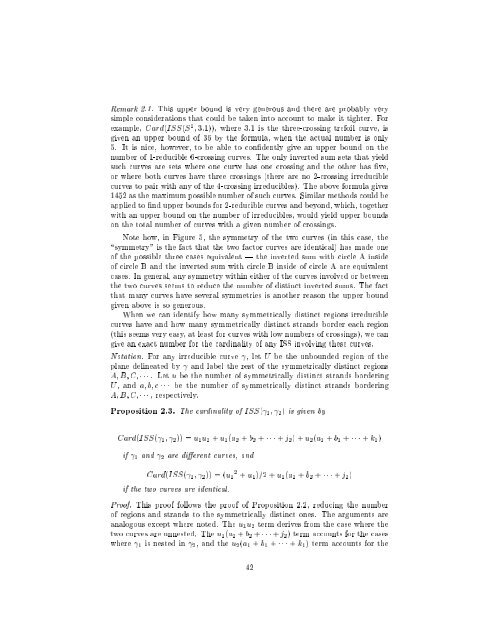Irreducible Plane Curves 1 Reducibility of Curves
Irreducible Plane Curves 1 Reducibility of Curves
Irreducible Plane Curves 1 Reducibility of Curves
You also want an ePaper? Increase the reach of your titles
YUMPU automatically turns print PDFs into web optimized ePapers that Google loves.
Remark 2.1. This upper bound is very generous and there are probably very<br />
simple considerations that could be taken into account to make it tighter. For<br />
example, Card(ISS(S 1 ; 3:1)), where 3:1 is the three-crossing trefoil curve, is<br />
given an upper bound <strong>of</strong> 36 by the formula, when the actual number is only<br />
5. It is nice, however, to be able to condently give an upper bound on the<br />
number <strong>of</strong> 1-reducible 6-crossing curves. The only inverted sum sets that yield<br />
such curves are sets where one curve has one crossing and the other has ve,<br />
or where both curves have three crossings (there are no 2-crossing irreducible<br />
curves to pair with any <strong>of</strong> the 4-crossing irreducibles). The above formula gives<br />
1452 as the maximum possible number<strong>of</strong>such curves. Similar methods could be<br />
applied to nd upper bounds for 2-reducible curves and beyond, which, together<br />
with an upper bound on the number <strong>of</strong> irreducibles, would yield upper bounds<br />
on the total number <strong>of</strong> curves with a given number <strong>of</strong> crossings.<br />
Note how, in Figure 5, the symmetry <strong>of</strong> the two curves (in this case, the<br />
\symmetry" is the fact that the two factor curves are identical) has made one<br />
<strong>of</strong> the possible three cases equivalent | the inverted sum with circle A inside<br />
<strong>of</strong> circle B and the inverted sum with circle B inside <strong>of</strong> circle A are equivalent<br />
cases. In general, any symmetry within either <strong>of</strong> the curves involved or between<br />
the two curves seems to reduce the number <strong>of</strong> distinct inverted sums. The fact<br />
that many curves have several symmetries is another reason the upper bound<br />
given above is so generous.<br />
When we can identify how many symmetrically distinct regions irreducible<br />
curves have and how many symmetrically distinct strands border each region<br />
(this seems very easy, at least for curves with low numbers <strong>of</strong> crossings), we can<br />
give an exact number for the cardinality <strong>of</strong>any ISS involving these curves.<br />
Notation. For any irreducible curve , let U be the unbounded region <strong>of</strong> the<br />
plane delineated by and label the rest <strong>of</strong> the symmetrically distinct regions<br />
A; B; C; . Let u be the number <strong>of</strong> symmetrically distinct strands bordering<br />
U, and a; b; c be the number <strong>of</strong> symmetrically distinct strands bordering<br />
A; B; C; , respectively.<br />
Proposition 2.3. The cardinality <strong>of</strong> ISS( 1 ; 2 ) is given by<br />
Card(ISS( 1 ; 2 )) = u 1 u 2 + u 1 (a 2 + b 2 + + j 2 )+u 2 (a 1 + b 1 + + k 1 )<br />
if 1 and 2 are dierent curves, and<br />
Card(ISS( 1 ; 2 )) = (u 1 2 + u 1 )=2+u 1 (a 2 + b 2 + + j 2 )<br />
if the two curves are identical.<br />
Pro<strong>of</strong>. This pro<strong>of</strong> follows the pro<strong>of</strong> <strong>of</strong> Proposition 2.2, reducing the number<br />
<strong>of</strong> regions and strands to the symmetrically distinct ones. The arguments are<br />
analogous except where noted. The u 1 u 2 term derives from the case where the<br />
two curves are unnested. The u 1 (a 2 + b 2 + + j 2 ) term accounts for the cases<br />
where 1 is nested in 2 , and the u 2 (a 1 + b 1 + + k 1 ) term accounts for the<br />
42

















